
How to Shut Off Main Water Valve
Before you head out of town, you’ll want to shut off the main water line to prevent any change of water damage while you’re away. Many water meter setups have two valves, one on the street side of the meter and one on the house side. If you live in a colder climate, you’ll typically find the main shutoff in the basement near the front of the house. In warmer climates, it will be outside your home attached to an exterior wall or in an underground box with a removable lid.
There are two types of main shutoff valves: the gate valve and the ball valve. The gate valve is common in older homes and has a round handle that must be turned a number of times to open or close the valve. Gate valves are designed to be fully open or fully closed. Water flowing through a partially open gate valve can wear away the metal and cause the valve to fail over time. The ball valve is more common in newer construction and has a lever handle that needs to be turned 90 degrees to turn the water on or off. You can immediately tell if it’s open or not: In the closed position, the lever is perpendicular to the pipes; in the open position it’s parallel.
If you’ve never shut off the main water valve before, test it before you leave on vacation. You’ll need an adjustable wrench, a bucket and slip joint pliers. Turn on a faucet somewhere in the house and shut off the main water valve. All water flow should stop. An old gate valve can break, so be gentle when you’re handling it. If the valve is stuck, leave it alone. If it leaks or doesn’t shut off all the way, have a licensed plumber replace the valve or replace it yourself if you’re comfortable with a straightforward plumbing project. You’ll need to call your water department (and possibly pay a small fee) to have the water to your house turned off at the curb stop while you make the repair.
If you have a well, shut off the electrical switch for the well when you leave for an extended period so it won’t pump any water while you’re gone.
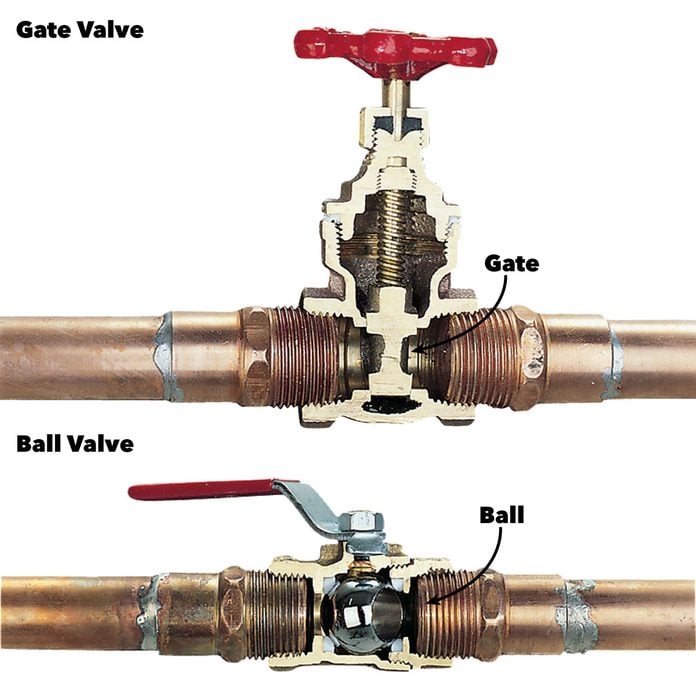
Types of Water Shut Off Valves
There are two types of main shutoff valves for a main water line. Gate valves (top) are common in older homes. The valve closes when a wedge-shaped brass gate is lowered into a slot. Ball valves (bottom), which contain a pivoting stainless steel ball with a hole drilled through the center, are less prone to wear.
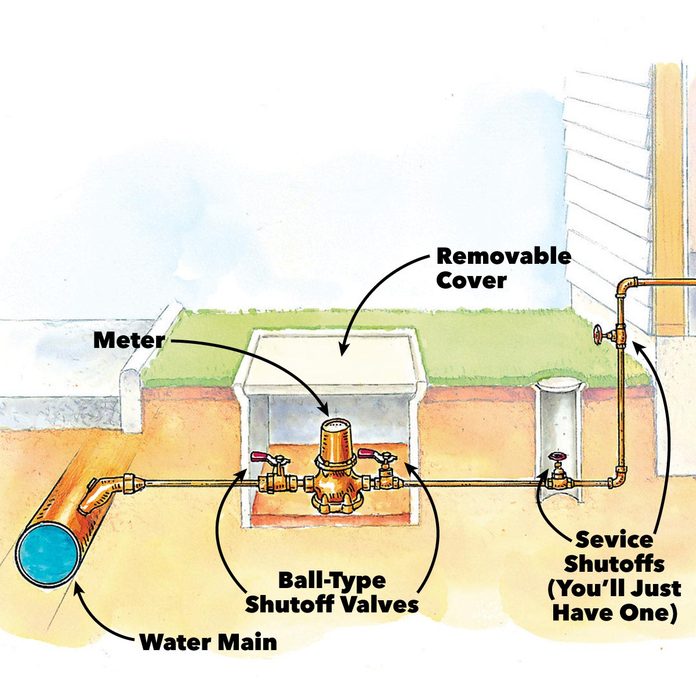
Outdoor Water Shut Off Valve
In warmer climates, the main water shutoff is typically outside, attached to an exterior wall or in an accessible underground box.
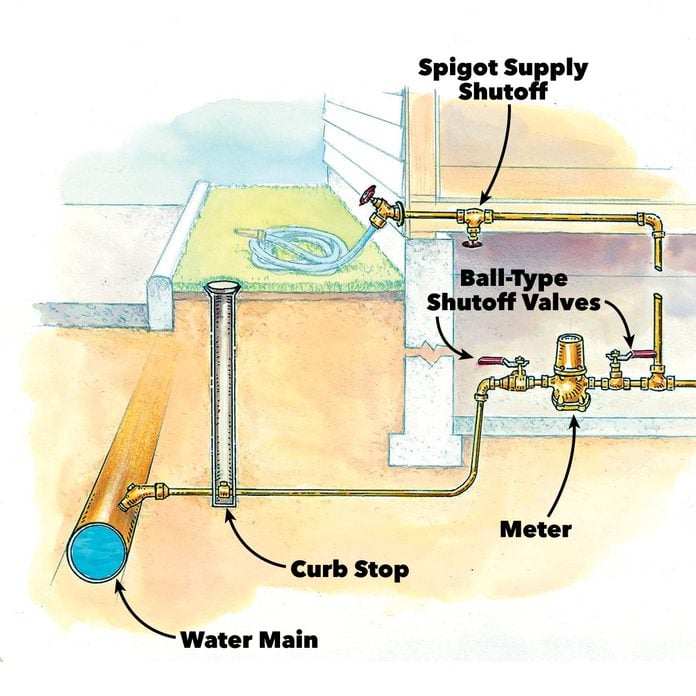
Indoor Water Shut Off Valve
In colder climates, the main water shutoff is typically in the basement.
Shutting off the main valve that controls all the water for your home is the best protection against catastrophic water damage. Everyone in your home should know where the main water shutoff valve is located so they can stop the water in an emergency. And you should turn it off whenever you leave home, even overnight. If you’re not sure where it is, look for your water meter; the main shutoff will be located nearby.
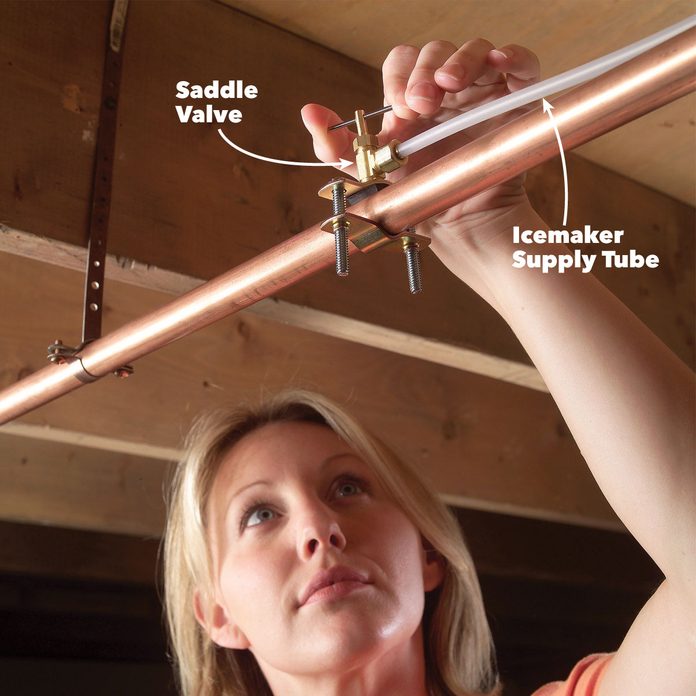
How to Shut Off Water Supply Valves
If you can’t shut off the main water supply because you have an automatic sprinkler system or someone watering the plants while you’re gone, shut off the valves to the most common sources of water damage such as dishwashers, icemakers and washing machines, in case a hose cracks or lets go. Individual shutoff valves or “stops” are installed on the supply lines leading to most appliances as well as to toilets and faucets. Typical supply stops have a small round or oval handle that you turn clockwise to shut off the flow of water.
The shutoff to your refrigerator’s icemaker might be located under the sink or in the basement. If your shutoff valve looks like the one to the right, consider replacing it with a standard shutoff valve. Did you know saddle valves violate building codes in some areas? Here are other readily available products that actually violate building codes.
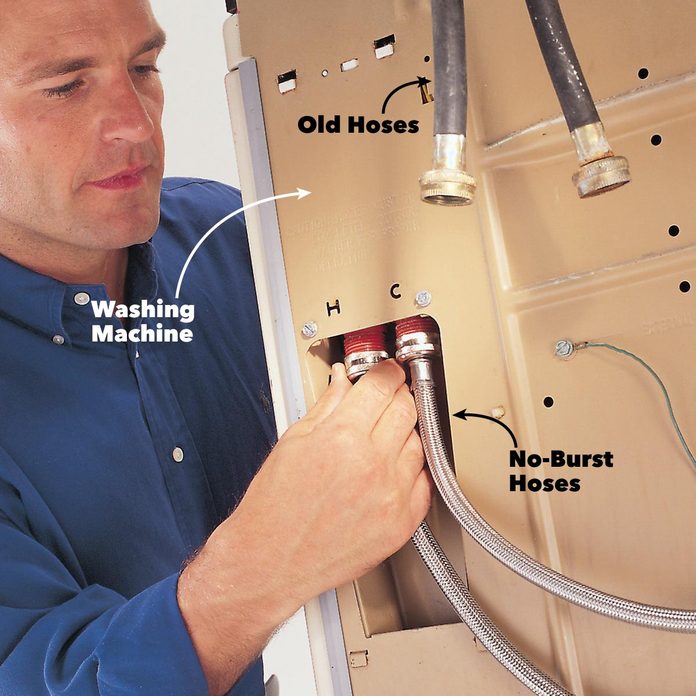
How to Check Water Supply Lines
Rubber or plastic supply lines that lead from shutoff valves to appliances, faucets and toilets become brittle and can leak or even break as they age. Since you’re messing with your shutoff valves anyway, inspect the supply lines too. If you find any leaks, cracks, bulges or signs of corrosion, replace the lines before you leave town. Your best choice is line encased in a braided stainless steel sheath. A pair of washing machine hoses costs less than $20 at home centers. Shorter versions for faucets or a toilet are also available.
Don’t wait for a vacation to check your supply lines. With 10 minutes and a flashlight, you can inspect every line in your house.
Stainless steel braided hoses last longer than rubber or plastic hoses and are less likely to leak. They also prevent mice from gnawing through the lines. Here’s how to get your gutters ready for fall and winter.

How to Test a Sump Pump
Sump pump systems help keep groundwater out of your basement. Before a vacation, test your sump pump by filling the sump pit with water and making sure the pump is actually pumping out the water.
If it doesn’t, be sure the sump pump is plugged in (a surprisingly common oversight) and check the breaker as well. Also make sure the outlet pipe isn’t frozen or clogged and that it directs water away from your home. Clean the hole in the discharge line and check that the motor is running smoothly. Also consider adding a backup battery to your sump pump so that it functions during power outages, which seem to go hand-in-hand with heavy rainstorms.

How to Check Your Gutters
A 1,000-sq.-ft. roof will shed about 620 gallons of water during a 1-in. rainfall, or about 103 gallons per downspout if you have six downspouts. That’s a lot of water dumped right next to your basement. Although it may seem obvious, clean and properly functioning gutters with downspouts that empty away from the foundation are key to avoiding major and expensive home repairs.
So before you leave for a vacation, take a walk around the house and check your gutters. Check to see if leaves, sticks or other debris are blocking the inlet of the downspout and preventing water from flowing down the spout. Also make sure your downspout extensions are discharging the water far enough from the foundation and that you always reattach them after you mow your lawn.
Downspouts should discharge water at least 10 ft. from the house. If yours don’t, consider adding extensions.
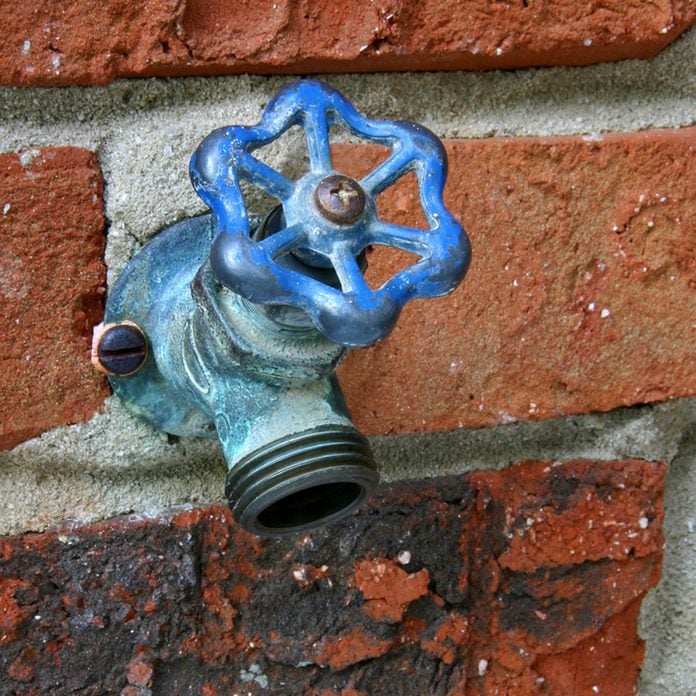
How to Shut Off Water to Exterior Faucets
Outdoor faucets are the first plumbing parts to freeze and burst when the temperature drops. So always close the supply shutoff valve inside the house before you head off on vacation (see Figure B). This is a good idea even if you have a frostproof faucet, since you’ll probably turn down the thermostat when you leave home. After turning off the supply shutoff, open the outside faucets to drain the remaining water out of the pipes. Never leave a hose connected to an outdoor faucet: It traps water in the faucet, which can freeze and crack open the faucet.
Another tip to avoid frozen plumbing is to turn the heat down to 60 degrees F when you leave, but not lower. You want to keep things warm enough inside the house so that water pipes running through exterior walls don’t freeze and burst.
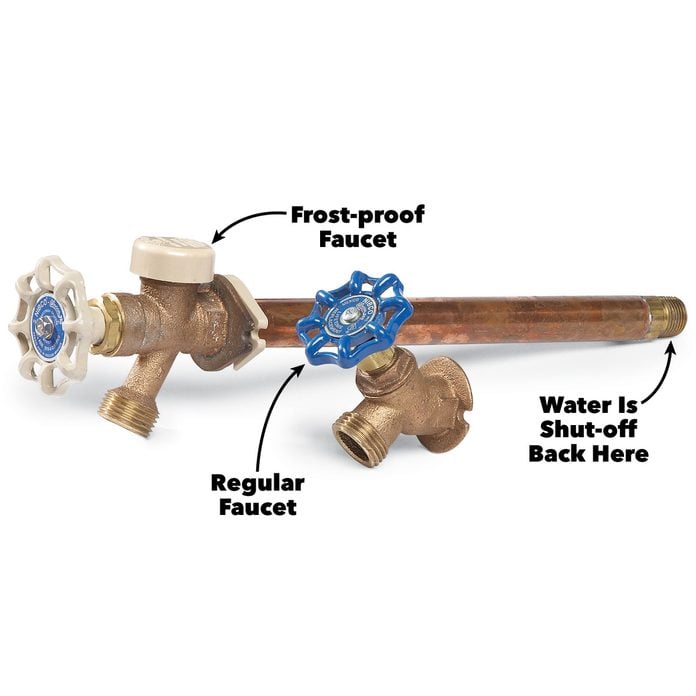
Install a Frost-Proof Faucet
A frost-proof faucet stops the water far inside the warm house to prevent freezing. If the handle on your faucet is level with the pipe, it’s a frost-proof model. We’ll walk you through installing a frost-proof outdoor faucet here.
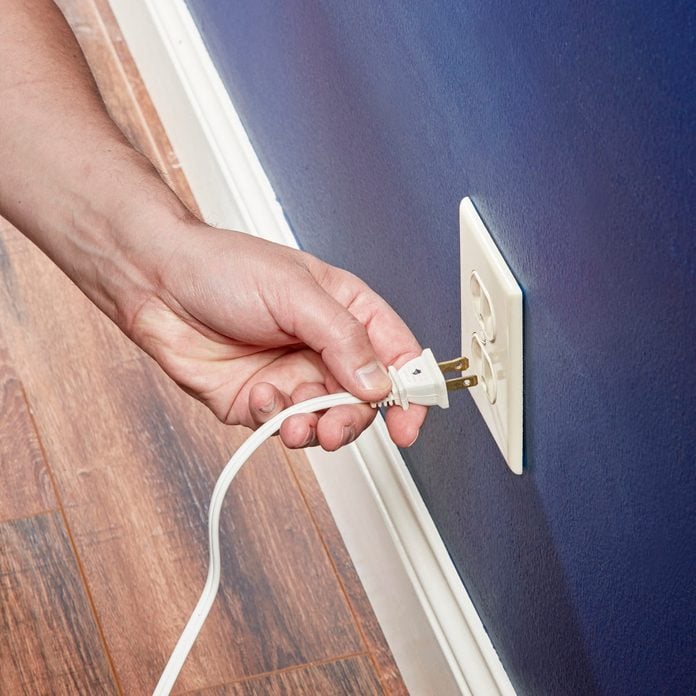
Energy Saving Tips
- Unplug appliances that consume electricity even when they’re not in use such as DVD players, microwaves, coffeemakers and computers (also make sure to disconnect the computer from the Internet). This is both a cost savings and a safety issue. It’s not unheard of to have a cat tiptoe across a counter and unwittingly turn on the coffeemaker.
- Turn the water heater down to the “vacation,” “low” or “pilot” setting.
- During the winter, set your thermostat to 60 degrees F and have a neighbor check on the house regularly for furnace malfunctions.
- In the summer, set your air conditioner to 85 degrees F so it runs less often but keeps electronics cool and gives the house an occupied appearance. Having no air conditioner humming and no windows open on a sweltering day is a sure signal to a thief that no one is home.
- If you’ll be gone for an extended period, clean out the fridge (and freezer) completely, shut it off and leave the door propped open.
Here are the pro’s and con’s of a tankless water heater:

Home Water Safety Devices
Water home safety devices will keep you home protected should anything ever go wrong with your water. These devices are an added pro-caution that you won’t regret purchasing come an emergency.
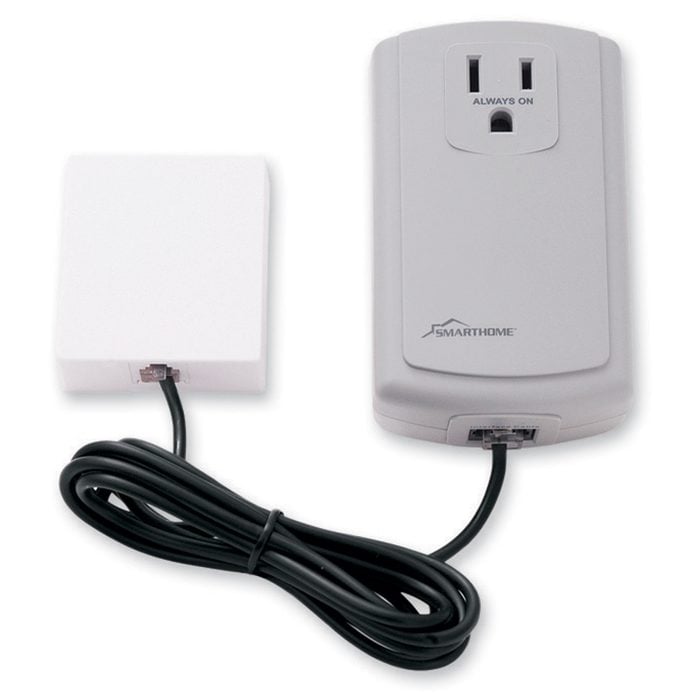
Temperature sensor
Temperature sensors detect furnace breakdowns and can help prevent frozen pipes and resulting water damage when interior temperatures dip. These temperature sensors, which come in battery-operated models and versions that can be plugged into a wall outlet, turn on or off any device plugged into them depending on the air temperature. A lamp plugged into the sensor will turn on when the temperature inside the house falls below a certain level, alerting a neighbor to call you or a service person.
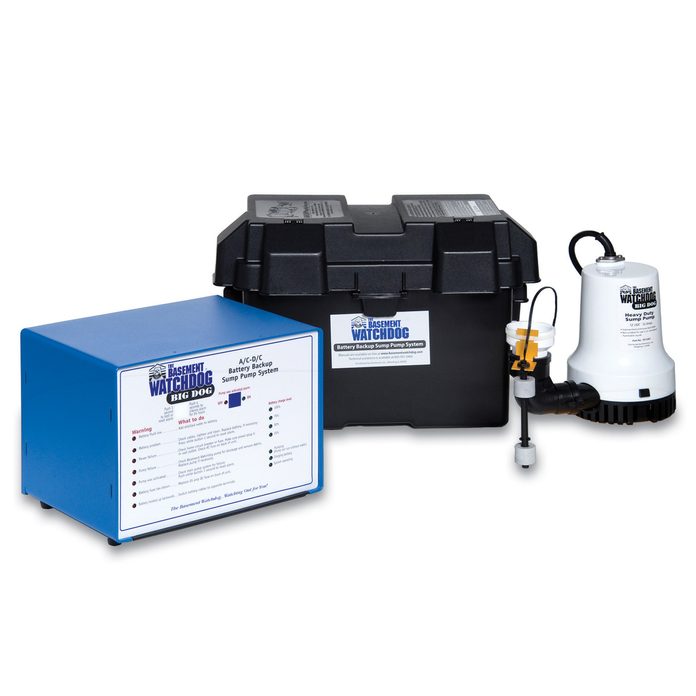
Backup sump battery
Emergency backup battery systems for sump pumps keep pumps functioning during power failures. The systems provide a separate battery-driven sump pump and controller that works during power outages and sounds an alarm when sump maintenance is needed or a battery problem is detected.
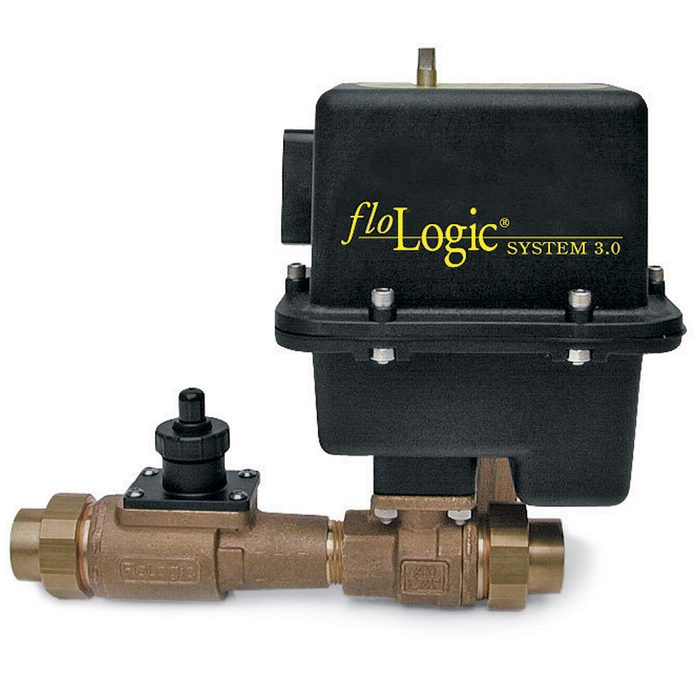
Water flow sensor
A water flow sensor can be installed on a home’s main water line. It is programmed to allow normal water flow during a selected period of time. If water flow exceeds a specified amount, a valve will close to stop the flow of water. A monitor that recognizes continuous water flow that exceeds normal use and responds by shutting off the water supply and sounding an alarm at the monitor keypad is also available.
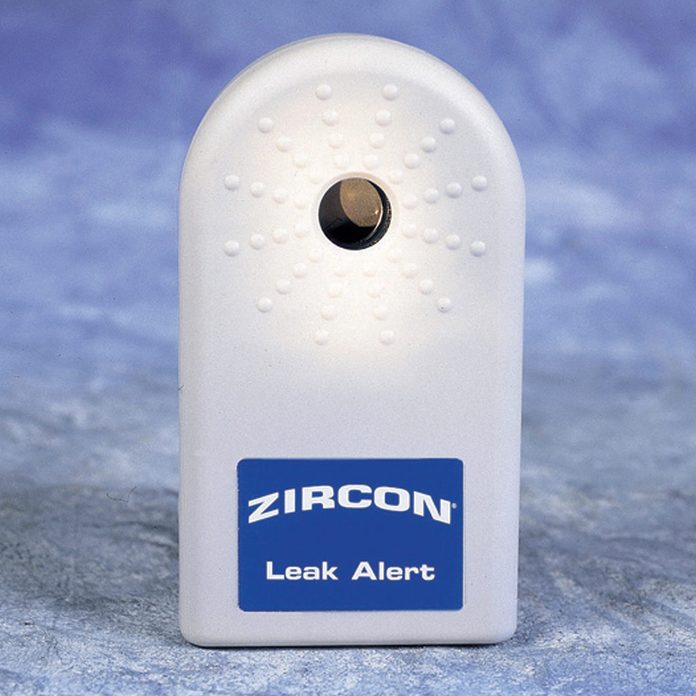
Electronic leak detector
Electronic leak detectors use wireless water sensors to sound an alarm when they detect water (battery-operated models) or are wired to an automatic shutoff valve on your main water line or at individual shutoffs. When water touches the sensor, the valve closes. Some monitors can also be wired into a centrally monitored alarm system, and some versions provide options for calling you by phone when the alarm sounds.